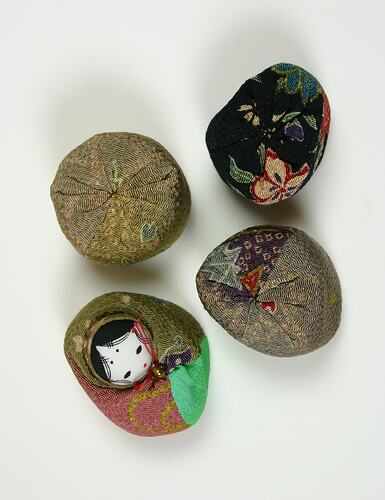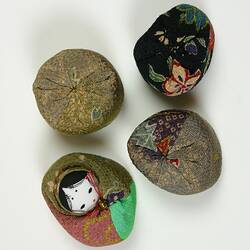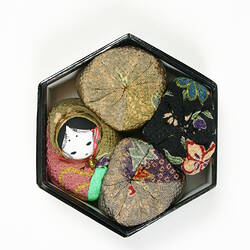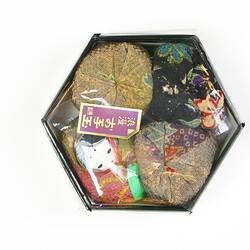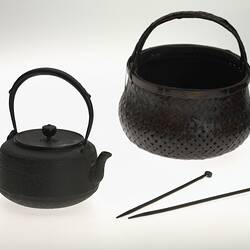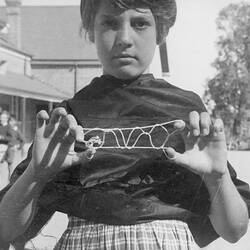Summary
Alternative Name(s): Japanese Jacks, O-Tedama
Set of four fabric jacks, called 'otedama' in Japanese. They were purchased by the donor in Japan in the late 1980s. Such toys were played with by children throughout Japan when the donor was growing up but are now only sold at more specialised stores. The donor brought the toys to Australia in her capacity as a cultural ambassador, introducing Australians to Japanese traditions. Some of these toys were previously displayed in Museum Victoria's Children's Museum, where the donor conducted several workshops from 1989 to 1993. These workshops introduced children to playing with such toys and to making origami.
Playing otedama with small fabric bean bags is a traditional game for Japanese girls. The otedama are usually small bags, made from fabric and filled with beans or rice to give them weight. More decorative otedama are sometimes made as presentation pieces for gifts or for display. The game is played in a similar way to Knucklebones, and it is sometimes accompanied by a musical chant. One informant preferred a juggling-style of play. Many otedama survive from the Edo period (1603 to 1868).
Part of the Australian Children's Folklore Collection (ACFC). The ACFC is unique in Australia, documenting contemporary children's folklore across Australia and in other countries reaching back to the 1870s. The Collection has a strong component of research material relating to Victoria.
Physical Description
The four jacks are composed of fabric sacks filled with a coarse, loose material. One of the jacks has a cloth, painted face with a gold bead and red threads beside it. They are housed in a black hexagonal box with a fitting lid. The box is wrapped in plastic packaging with a small gold and maroon sticker bearing untranslated Japanese print.
More Information
-
Collection Names
-
Collecting Areas
-
Acquisition Information
Donation from Mrs Masumi Hiraga, 13 Feb 2007
-
Place & Date Made
-
Collector
-
Inscriptions
Gold ink on maroon sticker. Untranslated Japanese script.
-
Classification
-
Category
-
Discipline
-
Type of item
-
Overall Dimensions
5 cm (Length), 4 cm (Width)
size of each top
-
Other Dimensions
10 (Length), 8.7 (Width), 3.5 (Height)
Measurement of overall packaging.
-
Maximum dimensions
108 mm (Length), 108 mm (Width), 40 mm (Height)
Measurement From Conservation.
-
References
Japan: An Illustrated Encyclopaedia(Kodansha Ltd., Tokyo, Japan, 1993); Japan at a Glance (Kodansha International Ltd., Tokyo, Japan, 1997); [Link 1] Traditional Toys of Japan (Craft & Folk Art Museum, Los Angeles, 1979). Further information information on otedama supplkied by Natsuko, a Deakin University student, April 2010.
-
Keywords
Children's Play, Early Childhood Development, Games, Japanese Toys, Toys, Making History - Australian Childrens Folklore
